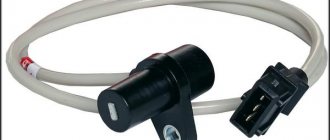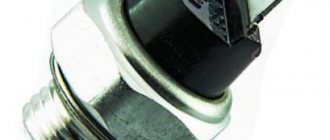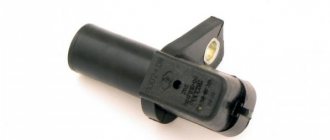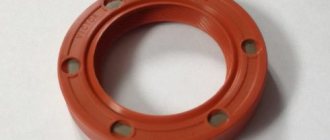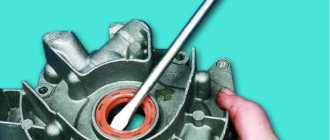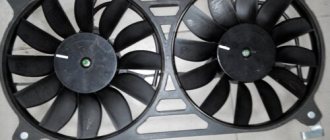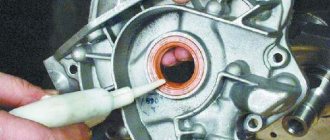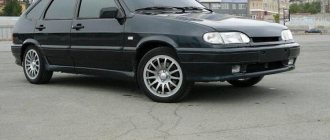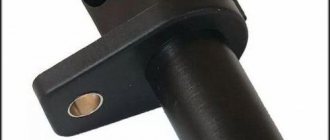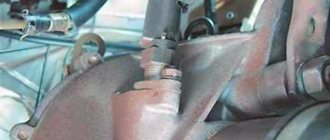The crankshaft position sensor is also called a synchronization sensor - a device for measuring the position of the crankshaft, speed, direction of crankshaft rotations and synchronizing this process with spark formation and fuel supply. In the process of working with DPKV Logan, pulses are read, on the basis of which the computer synchronizes the operation of the following parameters:
- Timing, gasoline supply volume
- Precise ignition timing
- Camshaft rotation amount
- Engine speed readings provided by the tachometer
- Other indicators, depending on the car model, for example, torque, duration of opening of the absorber valve
Depending on operating conditions, the service life of the Renault Logan crankshaft sensor is 65-75 thousand km.
The unit is one-piece and cannot be disassembled or repaired, so replacement is the only way to restore operation . The procedure is simple, you can do it yourself.
Renault Logan crankshaft position sensor
The design of cars is constantly changing, and if earlier cars used carburetor engines, now a complete transition has been made to injection engines.
With the introduction of injection engines and on-board computers, crankshaft sensors began to be used. The Renault Logan crankshaft sensor (RPKV) collects data on the position of the crankshaft, and also determines the moments when the first and last cylinder are at the top and bottom dead centers. All measurements are transmitted to the vehicle's electronic control unit. After the electronic control unit receives the data, the DPKV adjusts the operation of the vehicle. The adjustment consists of the camshaft rotation angle, the amount of fuel entering the cylinders, determining the ignition timing and the timing of gasoline supply.
The principle of operation of the DPKV is quite simple; a special wheel made of teeth is used on the crankshaft. This wheel is missing two teeth - zero and starting. The wheel is constantly spinning and, thanks to a magnetic field, transmits data to the electronic control unit. As soon as the wheel slips near the sensor with zero and starting torque, the electronic control unit finds the initial position of the crankshaft. Based on the data received, the vehicle system begins to adjust its operation.
The key feature of the crankshaft sensor is that it cannot operate periodically, namely: either in normal condition or switch off. DPKV either works fully or does not work at all. It is impossible to repair the sensor, so if it breaks, you will have to purchase a new one. Signs of failure of the DPKV may include the following operating features:
- When you press the gas pedal, the car gains power poorly;
- When the engine is running, the speed constantly jumps;
- The car engine does not start;
- When the engine is loaded, explosive ignition of the air-fuel mixture occurs.
If a malfunction is suspected, the DPKV is diagnosed. When connecting the tester, a metal element is brought to the DPKV. The tester should currently display voltage.
On Renault Logan, replacing the crankshaft sensor is quite simple; you need to disconnect the air intake hose, the harness block together with the wires and remove the bolts from the fastenings. After this, the Renault Logan crankshaft sensor can simply be disconnected from the internal combustion engine. You can install it by repeating the procedures in reverse order with a working new sensor.
VESKO-TRANS.RU
AutoNews / Reviews / Tests
Replacing the Crankshaft Sensor Renault Logan
Such a small part as the unique idle speed sensor on Renault Logan cars is an integral part of the engine system. It is responsible for idling the engine, regulates the supply of fuel to the system and prevents unexpected engine shutdown. Renault Logan had a problem replacing the "natural crankshaft sensor on engines". vehicle operation is broken, which means it's time to diagnose or replace the idle speed sensor.
Location, structure and principle of operation
DXX Renault Logan with engine capacity 1.4 (8 cl) and 1.6 (16 cl) is located on the throttle flange, and since the car is equipped with an injector, its operation is controlled by a computer.
The sensor is the main element in the engine idle system and regulates the rotation of the crankshaft. After the seal replacement verdict, Renault has a crankshaft seal (Megan 2 1. This is due to the amount of air flowing through the bypass, which acts in conjunction with the throttle valve.
The efficient operation of the sensor is maintained by the electrical control unit when the engine reaches the appropriate temperature. If the engine is cold, the unit monitors and controls the valve using electrical impulses, increasing the speed needed to warm up. When the engine reaches operating temperature, the rpms jump and drop.
Depending on the year of manufacture (2006-2017) and the number of hp engines. (102 or 86) Renault Logan, all cars are equipped with IAC VDO office. If necessary, you can install a new unique version of the part, as well as its analogue, the main thing is to choose it based on the article. Only the cost of the device will be different, but the operating mechanism will remain the same.
Problems and solutions
Among the common defects of a Renault
Logan problem 2006–2016.
This is a situation where there is no idle . Front hub bearing replacement for Renault Logan (renault. The following are common symptoms:
- The machine shifts and rocks him;
- The engine maintains high speeds;
- There is a sudden decrease in speed causing the engine to stop unintentionally;
- Noise, roar, whistle;
- Rough engine operation in cold weather;
- There is a vibration of the body;
- High fuel consumption.
There could be several reasons why KXX is not working properly:
- Regulator failure. The ECU will report such a problem and then the part must be replaced. At the same time, if the fault signal first appeared and then suddenly disappeared, and its operation was accompanied by a whistle, then the valve has failed;
- Lack of sealed pipe connections. How to check Renault Logan crankshaft sensor to replace crankshaft sensor 12. For the sensor, how to see the crankshaft position sensor markings on Renault Logan. In this case, check the clamps.
Diagnostics and replacement of DC Renault Logan
Replacing the sensor
oxygen
Renault Logan
.
How to check the crankshaft sensor Renault Logan at home
DPKV sensor
position
crankshaft
. If it's faulty or the car is dirty, you'll either be in bad shape.
Easily change the part yourself. Replacement cabin filter for Renault Logan 2, replacement cabin filter for Sandero activated. To do this, you need to purchase a catalog of sensors, the number of which for the engine is 1.4. 7701206370, and for 1.6. 7701047909. The most popular and reliable devices are VDO and ERA, for which the manufacturer provides a long warranty. To replace the brake light, you need to remove the Renault Logan headlight from the seat in advance. They are great for cars 2009, 2010, 2015 and others, for 16 V and 8 V engines. However, there are good budget analogues that can be easily adapted to the Logan model.
The replacement process consists of the following steps:
- The car needs to be turned off. disconnect the ground wire from the battery;
- Run around disassembling the air filter;
- Remove the sensor connector.
Often the device malfunctions due to dirty connectors. In this case, cleaning them and adjusting them may solve the problem. Spare front wheel bearing for Renault Logan with and without abs. Chassis maintenance and front wheel bearing replacement on Renault Logann. a common and important task. In addition, the drive should also be cleaned for preventive purposes, thereby increasing the longevity of the workpiece.
- A screwdriver unscrews the valves that secure the regulator to the body and reveals the sensor;
- Before installation, clean the mounting point and connect the new device.
You can find a large number of photos and videos online that show how to flush or replace the XX controller if it gets dirty.
cleaning
The presence of dirt on the sensor or throttle connectors is one of the main reasons why the body may vibrate with the workpiece, the engine does not run smoothly and the speed floats. The cleaning process consists of several stages:
- The air filter under the cover is switched off;
- The first pipe is located under the throttle;
- After disconnecting the connectors, the sensor
and shock absorbers; - The throttle has been removed;
- The installation site is cleaned using special tools;
- The controller has been disassembled and its components cleaned;
- The structure is assembled in reverse order.
If after such work the speed continues to jump or rise, the engine heats up very much and braking occurs unevenly, then most likely the sensor should be replaced.
calibration
After installing a new element, calibration is necessary for high-quality operation. Failure to do so will affect the operation of the vehicle. the revolutions will be repeated, their gas intensity does not change when you press the gas, the car starts poorly, etc. Renault Logan filter for installing and replacing the interior. There are two ways to do this:
In the first case, the cost of work can lead to a round sum. The second option is discussed below:
- The negative terminal of the battery is installed and the calibration data for the new device must be reset;
- The engine starts (until the speed can float);
- The engine is turned off (rotation of the MAC rod moves it to another position);
- The procedure is repeated several times;
- At the end, the engine should be started and well warmed up.
After this calibration, the speed will be in place and the engine will run smoothly and efficiently.
Conclusion
A hot or cold engine should not be idled. The sensor is responsible for this. idling
, the correctness of which should be monitored by every car owner and promptly take corrective action.
Renault Logan crankshaft sensor
The crankshaft position sensor (hereinafter referred to as CPPS) is designed to read the number of crankshaft teeth and transmit data online to the electronic control unit (ECU).
The on-board computer analyzes the received data, increases and decreases the crankshaft speed, and restores the ignition timing.
The average service life of the controller is 65 – 75 thousand km. Since the equipment is not dismountable, it cannot be prevented; it must be replaced entirely.
During systematic use of the vehicle, the sensor wears out, as evidenced by unstable engine operation. The process of self-replacement is not at all difficult, but requires care on the part of the repairman.
Crankshaft sensor for Renault Logan: what it does, where it is located, price, part numbers
What the controller is responsible for:
- Fuel injection phase synchronization;
- Supplying a charge to ignite the fuel in the combustion chamber.
The timeliness of supplying the fuel mixture to the combustion chamber depends on the functionality of the controller.
As the teeth pass, the DPKV reads their number and sends the received data to the ECU. The control unit increases or decreases the number of revolutions.
The angle of the teeth is six degrees. The last two teeth are missing. The "cut" is made to center the crankshaft pulley at TDC.
Where is the controller located: in the engine compartment, under the exhaust manifold cover. Access to preventive maintenance equipment is through the top of the engine compartment.
Note to the driver. Carrying out maintenance from under the bottom of the car is also permissible, but not effective due to limited space.
Signs of a faulty crankshaft sensor:
- The engine does not start;
- Difficulty starting the engine;
- Idle speed is unstable;
- Sudden drop in power of the power unit;
- Detonation during operation;
- Passive acceleration dynamics;
- Increased fuel consumption;
- When driving “downhill,” the engine does not have enough power and “requires” a transition to a lower row.
The indicated symptoms are also signs of other malfunctions. Carry out comprehensive diagnostics using digital equipment for data objectivity.
| Name / catalog item | Price in rubles |
| Maxgear 24-0043 | From 600 – 650 |
| StartVOLT VS-CS 0901 | From 600 – 650 |
| Autolog AS4124 | From 600 – 650 |
| Lucas SEB1780 | From 600 – 650 |
| Autolog AS4260 | From 600 – 650 |
| Meat & Doria 871751 | From 600 – 650 |
| Kamoka 109007 | From 800 – 1000 |
| Maxgear 24-0071 | From 800 – 1000 |
| Autolog AS4850 | From 800 – 1000 |
| Stellox 0600003SX | From 800 – 1000 |
| Hoffer 75174841 | From 800 – 1000 |
| Meat & Doria 874841 | From 800 – 1000 |
| VDO A2C59513358Z | From 800 – 1000 |
| VDO S119915001Z | From 800 – 1000 |
| ERA 550467 | From 800 – 1000 |
Technical characteristics of DPKV:
- Winding resistance range: 810 ohms;
- Winding inductance: 277 MHz;
- Minimum sensor voltage amplitude: 0.28V;
- Maximum amplitude: 222V;
- Dimensions: 36x49x90 mm;
- Weight: 64 grams.
Self-diagnosis instructions
You can check the controller with special equipment - a multimeter.
- Open the hood and under the exhaust manifold we find a block with wires from the crankshaft sensor. Disconnect;
- We connect the terminals from the multimeter to the DPKV. We measure the resistance. The permissible range is 750 - 800 Ohms. Exceeding or underestimating is a sign of a malfunction.
- We make a decision on the advisability of replacing or installing new equipment.
Causes of premature wear of the DPKV
- long-term operation without prevention;
- manufacturing defects;
- third-party mechanical damage;
- getting sand, dirt, or metal shavings inside the controller;
- sensor breakage due to crankshaft teeth;
- damage to the DPKV during repair work;
- short circuit in the on-board circuit.
Site navigation
The DPKV is installed in the vicinity of the crankshaft pulley, which has 58 metal teeth located at the same distance from each other, while on a certain section of the pulley there is a small gap that corresponds to the position of the crankshaft relative to the top dead center of TDC in the 1st and 4th cylinders of the engine. At the time when the sensitive part of the sensor enters this sector, there is an increase in the interval of pulses that are transmitted to the ECU, which is a signal to synchronize the supply of the fuel mixture to the combustion chambers through the injectors and the occurrence of a spark on the electrodes of the spark plugs in gasoline engines.
Location of the DPKV or where the crankshaft sensor is located As a rule, the crankshaft sensor is installed near the crankshaft pulley itself, which is not a very convenient location for connecting it to the on-board network and, accordingly, diagnosing it.
How to replace the crankshaft sensor on a Renault Logan car yourself
The replacement process is simple; the task is feasible for every car enthusiast. The time interval is 10 - 15 minutes, if you have tools and a spare part.
Required materials and tools:
- wrench “10”, socket, wrench, flat-tip screwdriver;
- rags, additional lighting as needed;
- new controller.
Step-by-step DIY replacement guide:
- we place the car on an overpass (inspection hole);
- under the exhaust manifold we find a block with wires, disconnect the terminals;
- Unscrew the DPKV lock (key set to “10”);
- we remove the controller, carry out troubleshooting of the seat, clean it from residual dust and dirt;
- insert the new sensor, screw it on, and assemble the structure in reverse order.
DIY replacement completed.
If you find signs of a controller malfunction, immediately contact a service station for a comprehensive diagnosis. Unprofessional intervention in repairs does not guarantee full functionality of the equipment.
Source
Detonation
The detonation controller on Logan is installed on the cylinder block, in particular, between the second and third. It is best to change the knock sensor after the car is driven onto an overpass or into a garage with a pit.
This is necessary because the knock sensor is located in an inconvenient location and can be difficult to access:
- First of all, you need to squeeze the latch and move the block with the wire to the side.
- Using a 24mm wrench, unscrew the element and remove it.
- Install the element in reverse order.
Logan also has many other components installed - a reverse sensor, an oxygen sensor or lambda probe, a fuel level sensor, a crankshaft sensor, and an anti-lock braking system regulator. All these parts, be it a reverse or speed sensor, are changed according to the same principle - the block with the wire is disconnected, after which the part is removed and replaced with a new one.
Sorry, there are no surveys available at this time.
DPKV Renault Logan: Purpose, Breakdowns, Check
The crankshaft position sensor on Renault Logan is also called a synchronization sensor. This device is designed to determine the position of the crankshaft, as well as its speed and direction of rotation.
He is responsible for the coordinated operation of the crankshaft with the spark supply process and fuel supply. The computer receives impulses from the Logan DPKV, and it, in turn, synchronizes the following processes.
- Timely supply of the required amount of fuel.
- Timely ignition.
- Characteristics of crankshaft rotation.
- Tachometer readings about engine speed.
- Valve opening processes.
Every approximately 70 thousand kilometers of Renault Logan, the crankshaft sensor must be diagnosed or replaced. However, this depends on the nature of the vehicle's operation.
Calibration
Since we remove the terminal from the battery for a long time, the ECU resets the calibration values of the XX regulator.
You can calibrate the sensor in 2 ways: using dealer equipment at a service station or manually. Let's take a closer look at the second option.
The vehicle's engine ECU updates the calibration positions of the XX sensor locking elements each time the power unit is started and when the vehicle reaches a speed of 50 km/h with uniform acceleration.
The calibration process consists of fully retracting the locking element and then releasing it until the valve is completely closed. Simply put, to calibrate the Renault Logan XX valve, it is enough to slowly accelerate to a speed of just over 50 km/h.
There is an alternative method in which you do not need to accelerate the car:
- Connect the negative terminal back to the battery.
- Turn on the ignition, wait 10-15 seconds without starting the engine. The regulator rod moves to its extreme position.
- We start the car. At this moment, the engine operates at high speed.
- We wait 1-1.5 minutes and turn off the engine. The XX regulator rod moves to its extreme position.
- Repeat steps 3 and 4 five times.
- We start the car again and let it idle for about 5 minutes. The XX speed will automatically reach the desired value.
Device
The modern automotive industry is gradually moving away from carburetor-type engines, increasingly giving preference to injectors. To operate such engines, an electronic unit is used that receives signals from all sensors. Next, the ECU is connected to send impulses to their destination in a timely manner.
Visually, the crankshaft sensor is a core with a wound wire. On top of it is a plastic case or adhesive filling. This element rarely fails, but situations occur that require its replacement.
Operating principle
The crankshaft sensor became necessary when there was a complete transition from carburetor to injection engines. Together with injectors, on-board computers began to appear in car interiors.
- The crankshaft sensor systematizes data on its operation and determines the position of the cylinders at dead centers.
- This data is then transmitted to the electronic control unit.
- And the electronic unit, in turn, sends a signal about the adjustment.
- The sensor makes changes according to the requirements of the unit.
- For this purpose, a gear is located on the crankshaft. But there are no two teeth here. They are called zero and starting.
- The magnetic field drives this wheel. At those moments when the wheel moves by the zero or starting element past the sensor, the electronic control unit records the initial position of the crankshaft. As a result, an adjustment occurs.
The main feature of the crankshaft sensor is that it cannot work poorly: either it is fully functional or it fails.
Tools:
Therefore, it is simply impossible to replace it with some analogues - it will not work. It should be selected strictly in accordance with the car model.
The sensor can be replaced at a service center or independently. If you have enough experience, knowledge and the necessary conditions for this, then by simply ordering a sensor from us, you can save on the services of professional mechanics. However, we hasten to warn everyone who is not confident in their abilities - it is better to turn to specialists. Replacing the crankshaft sensor Renault Logan 1. In this case, two teeth in a row out of 60 are missing, which is why a gap is formed.
When this depression passes past the sensor, a pulse is generated in it, which is transmitted through a wire to the engine control unit. The controller uses signals to determine the crankshaft rotation speed and generates corresponding pulses for the injectors. If you need to check and possibly replace it, it is not difficult to find the sensor - it is installed on the oil pump cover.
To remove the sensor, you will need to turn off the ignition, disconnect the wire, connect it to the sensor through the connector, unscrew the mounting bolt with a 10mm wrench and remove the DPKV from the oil pump cover bracket. It all depends on the engine model. If there is an A15MF valve under the hood 1. On a 1.6-liter F16MF power unit - opposite the drive ring at the rear end of the crankshaft. To replace a faulty DPKV, you will need a 6mm hex and a tester.
Part 12 Replacing the crankshaft sensor Renault Megane II PART 12 Replacement crankshaft sensor
After this, the wires are removed from the sensor by disconnecting the harness block. Use a hexagon to unscrew the sensor mounting bolt.
Where is the crankshaft position sensor usually located?
Then the part can be easily removed from the hole in the oil pump housing. Location of the crankshaft position sensor on Renault Logan engines Checking the crankshaft position sensor on Renault Logan engines may be required after only a thousand. Already after a thousand kilometers. Often the culprit in such cases is the DPKV. True, it may just be a slightly loose connector contact.
But if the problem takes on more serious consequences, for example, the power unit stalls or does not start, then it is most likely impossible to do without replacing the sensor.
Location
To find the crankshaft sensor under the hood, just look at the space between the transmission and the engine.
This device is usually located in the upper part of the flywheel housing. It must have a plastic or adhesive body, which is attached to the generator pulley using a bracket.
Therefore, we can say that the main location of the DPKV is the bracket of the central part of the generator pulley.
Symptoms of a problem
The driver needs to know the reasons for failure of the crankshaft sensor.
- Intermittent engine idling.
- The engine speed changes spontaneously.
- With increased engine load, engine detonation is noticed.
- The car is difficult to start, and engine power is significantly reduced.
The reasons for the incorrect operation of the DPKV may be contamination of the non-magnetized rod. In this case, it is enough to clean it.
Also, during operation, a wire break may occur, which will lead to the same symptoms.
It is very rare for a coil to break. To find out this fact, just call her. If there is a break, the device will not show anything.
Summarize
Taking into account the above, we can conclude that the crankshaft sensor is one of the most important elements in the overall electronic control circuit of the power unit. Failure of the DPKV will lead to a complete stop of the engine; malfunctions in its operation greatly complicate the operation of the vehicle or make driving a car almost impossible.
As for checking and replacement, at the very beginning you should make sure that there are no foreign objects in the gap between the sensor and the synchronization disk, and that the gap itself is within acceptable limits. At the same time, it should be taken into account that the device may be serviceable and operational, but the cause of failure is dirt on the DPKV core.
Examination
It is worth understanding that reliable diagnostics can only be performed by service center specialists using special equipment. But you can draw a preliminary conclusion yourself.
To check the serviceability of the sensor, it must be dismantled. Next, the tester is connected to the contacts. If you bring any metal object to the sensor, it should give off a pulse. When this does not happen, the DPCV is faulty.
The crankshaft sensor rarely fails. Replacing it is not difficult and is done in the reverse order.
Replacement
To do this you will need a new sensor, a 10mm wrench, a socket, a wrench and a screwdriver.
- To replace the top, you will have to disconnect the air pipe to gain access.
- On the right, you need to disconnect the chip from the sensor using the tab.
- Unscrew the fixing bolts.
- The old device is replaced with a new one and screwed on.
Finally, it is important to check the distance between the end of the DPKV and the teeth of the crankshaft pulley. It should be 1mm. If it is less, then the housing risks rubbing against the teeth; if it is more, then interruptions in engine operation may occur.
Source
Power steering pressure
To replace the power steering pressure sensor, you need to remove the power steering reservoir from the bracket, this will prevent fluid leakage:
- The power steering sensor should be disconnected from the electrical circuit; to do this, disconnect the power supply.
- Using a 22mm wrench, unscrew the power steering sensor; while replacing it, the installation site should be covered with a rag.
- Replace the device with a new one and replace the expansion tank.
Removing an element using a key
